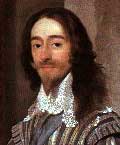| Second son of James VI of Scotland (James I in England) and Anne of Denmark; became heir apparent on the death of his older brother, Henry Frederick (6/16 Nov 1612); succeeded to his father's throne in 1625; in first years of his reign, he remained under the influence of George Villiers, 1st Duke of Buckingham; took a hostile attitude towards the Parliament, refusing to grant funds for the war with Spain and disapproving of the king's religious policies; convoked and dissolved three Parliaments in 1625-1629; ordered the adjournment of Parliament (1629) and had several parliamentary leaders imprisoned; governed without a Parliament (1629-1640) using forced loans and other extraordinary financial measures to meet governmental expenses; attempted to impose the Anglican liturgy upon Scotland that led to the Bishops' Wars (1639, 1640); summoned the Parliament in 1640 to raise an army and funds; abruptly dissolved it on 5/15 May 1640 ("Short Parliament") in response to demands of discussion of various abuses of power; summoned his fifth Parliament ("Long Parliament"), which turned against the chief royal advisers, William Laud and the Earl of Strafford, who were imprisoned and executed; assented to the Triennial Act (1641), mandating the summoning of Parliament every three years; received the Grand Remonstrance (22 Nov/2 Dec 1641), which was passed by the House of Commons and enlisted reform demands; ordered the arrest of six members of Parliament and entered the House of Commons with an armed force (4/14 Jan 1642), violating parliamentary privileges; abandoned London (10/20 Jan 1642), setting up his court at Oxford; raised an army, starting the Civil War (1642), which lasted until 1646 when the royalist troops were disbanded and Charles surrendered to the Scottish army (5/15 May 1646); having refused to accept Presbyterianism in Scotland, he was handed over as a prisoner to parliamentary commissioners in Newcastle (23 Jan/2 Feb 1647); was kidnapped by the New Model Army (4/14 Jun 1647) which turned hostile to the Parliament; escaped (11/21 Nov 1647) to the Isle of Wight, where he was kept under surveillance in Carisbrooke Castle; managed to negotiate with a Scottish group the secret "Engagement" (26 Dec 1647/5 Jan 1648), promising to establish Presbyterianism in England, triggering off the second phase of the Civil Wars, a series of Royalist rebellions, and a Scottish invasion (1648); after the defeat of the Scots at the Battle of Preston (1648), he was moved to Hurst Castle in Hampshire and thereafter to Windsor Castle; was tried by the court appointed by Parliament and sentenced to death as "a Tyrant, Traitor, Murderer, and a public Enemy"; beheaded in London. |
| [1] |
While Charles lost control over the government in the course of Civil Wars, he retained the title of King of England until the moment when he was executed. On 4/14 Jan 1649 the House of Commons declared themselves to have supreme authority, but Charles nominally remained King. "An Act of Parliament for the Trying of Charles Stuart, King of England" in addressing him so confirms that he was not deprived of his royal style. On the day of the execution (30 Jan/9 Feb 1649), the Commons of England in Parliament assembled issued "An Act prohibiting the Proclaiming any Person to be King of England or Ireland, or the Dominions thereof". |

